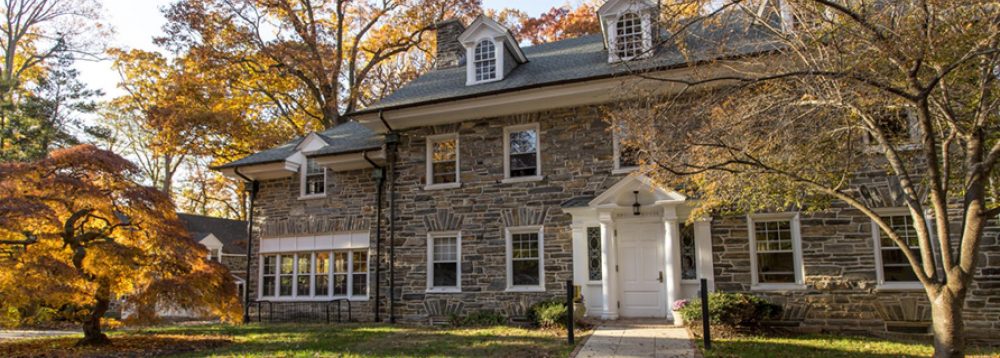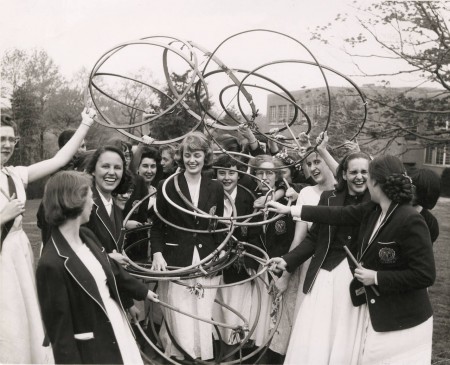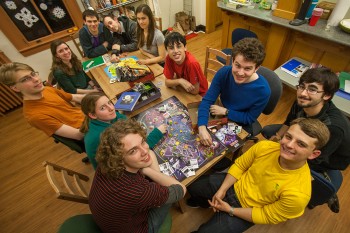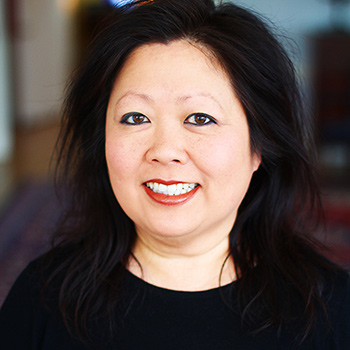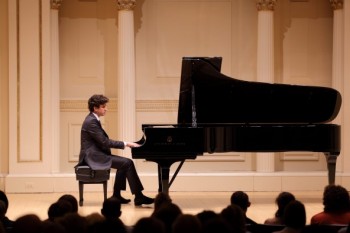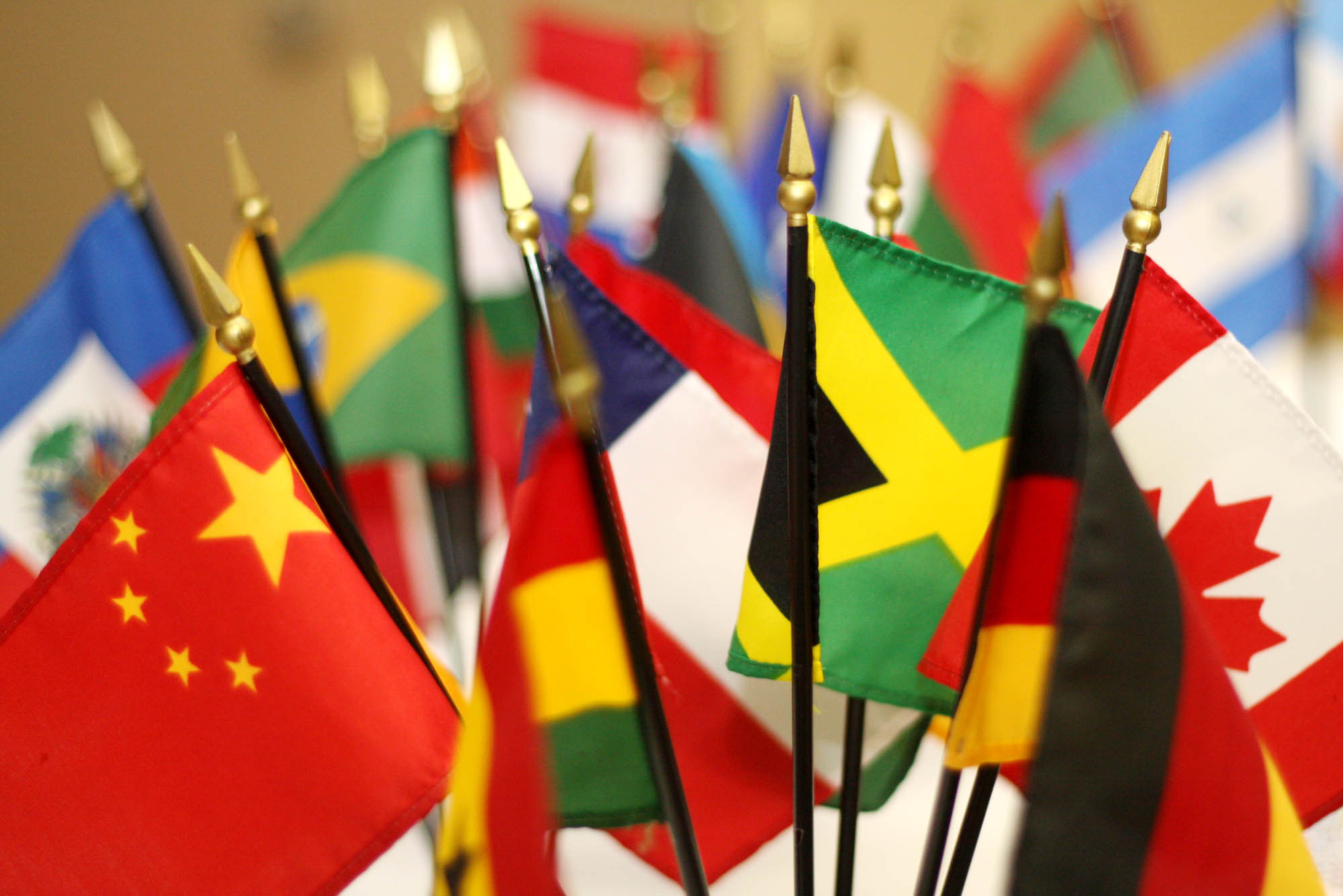THE MAY DAY GIFT IS A BRYN MAWR TRADITION
By Kelsey Rall
In room 54 of Rhoads North, one of BrynMawrCollege’s dorms, a little dinosaur pillow sits on a white chair. Its body is purple with small blue spots, and it has a yellow underbelly. A long neck curls around, over the dino’s body, and connects to its back via a small square of Velcro.
It’s nothing incredible; the years have left it somewhat dingy. It smells a little, and its clothe exterior does not have the same bright look it may have had when first purchased. The only thing that sets this little pillow apart from others is a crumbled five-by-eight note card, attached to the dinosaur’s back by a safety pin.
Written on the note card is a list of names and years. “To: Erin Hunter ’99…To: Molly Kaput ’02…To: Alex Tisman ’09…To: Tyler Williams ’12.” Thirteen names in all are written on the note card: the 13 previous and current owners of the dinosaur pillow. At the top of the list reads the following message: “HAPPY MAYDAY!”
The Dinosaur Pillow is one of thousands of May Day gifts given every year from seniors to underclassmen at Bryn Mawr. On the first Sunday of May, after the last classes of the spring semester have ended, students, faculty, and alumni gather together to celebrate the past year, and to wish the seniors good luck in the future.
It is customary to wear white, though some students spice up the ensemble with red shoes or colorful flower crowns. May Pole Dancing, concerts, feasting, parades, and carnival games occur throughout the festive day, but the most touching part of the day is the May Day Gifting, which happens early in the morning.
The night before May Day, seniors scramble from dorm to dorm, dropping off gifts to the underclassmen. Generally these gifts go to the underclassmen with whom the seniors have developed a close bond. According to Bryn Mawr’s official traditions page, “The tradition is that, if the gift has been handed down more than once, you must hand it down again when you graduate. Gifts that you receive that have only been handed down once, you may keep.” This clause has resulted in gifts that have been passed down for decades.
Taryn Traughber, a senior from Pocatello, Idaho said, “the oldest gift I have is an ‘Amateur Rugby’ poster from 1995.” Traughber is currently one of the captains of the Bryn Mawr-Haverford Rugby team, and the gift was handed down from a fellow player.
Lucy Gleysteen, class of 2014 from Lincoln, Massachusetts, also received an old rugby-related gift. She got a “bloody yellow and red rugby jersey.” She didn’t know the exact age or lineage of the strange gift “because so many of the names had wash[ed] off,” but she was “pretty sure the gift started in the 80s.”
Weird 90’s hair
Abby Crum, a sophomore from Ogdan, Utah also received a gift from the 90s. She said “the oldest and weirdest [gift I received was]…a book of hair tutorials from the 1990’s. I love it to death but the 90’s were a very strange time for hair.”
Aly Robins, a sophomore from Wayside, New Jersey, didn’t receive any gifts that were incredibly old. Instead, her oldest gift was “a plastic egg from the class of 2009.” Many May Day presents are strange, much like the plastic egg.
Generally, a May Day gift carries a special importance that only a certain group of Bryn Mawr students will understand, like Gleysteen’s bloody rugby jersey. However, some gifts don’t make sense even to the recipient, and would not be considered appropriate presents outside of the May Day context.
According to Robins, some gifts are given not because of a special importance or meaning, but because “it’s a better way to get rid of unneeded items as seniors transition to post-college life than the free box.” The “free box” mentioned is a special Bryn Mawr institution. On each hall of a Bryn Mawr dorm, there is a cardboard box next to the trashcans for unwanted items. Instead of throwing something away that could still be used, a student can place it in the free box with the hope that someday, another student might rescue the item from its cardboard limbo. Robins argued that certain May Day gifts are no more than re-routed free box items.
When asked what was the weirdest gift she had ever received, Robins said, “A senior from a club I’m in gave me a replica of a ship. I think she just needed to give stuff away. It doesn’t really matter, I love it and it classes my tiny room up.”
Another reason for bizarre gifts is that they are just funny. While May Day seen as an emotional day, and May Day gifting is generally viewed as a sentimental tradition, some gifts are given precisely because they carry no importance whatsoever. These are often the gifts that are the most memorable.
Most memorable
Traughber once got “a Dora the Explorer soft night stick.” Claire Romaine, a sophomore from Cincinnati, Ohio “only really got two gifts,” but her “hall mate was given a three-foot long, five-inch in diameter tree trunk” as a May Day gift.
Gabrielle Smith, a sophomore from Stroudsburg, Pennsylvania got two equally strange presents last May Day. Of them, she said, “I’m not sure if the bath toys or the shake weight is weirder. I’m still deciding.”
Christina Stella, a sophomore from Bethlehem, Pennsylvania had high hopes for her strangest gift. She said, “Somebody gave me an inflatable pool shark. I live my life waiting for the day it comes in handy, because it will.”
Anna Kalinsky, a senior from Chatham, New Jersey may have everyone beat on getting out-of-this-world presents on May Day. She said, “The weirdest gift [I’ve ever received for May Day] is probably [four] cans of knock-off brand Playdoh from 1993.” She confessed that she “opened one of them once”, but she has since vowed, “Never again.”
Each year, May Day is planned, organized, and managed by the two Traditions Mistresses. The role is voted upon by the student body every spring, and it is typically held by two juniors. Last year, Anna Sargeant, a current senior from Williamsburg, Virginia, was one of the two Mistresses. Her room has become a bit of a May Day gift shrine over the years. Every available surface is covered in items that have been handed down for years, and some for decades. For overflow gifts (of which there are several), the Bryn Mawr senior has a large grey box. When all of her gifts are stored inside of it, “it’s filled to the brim.”
Sargeant said, “I have a number [of gifts] from the 80s and 90s”, though she has several that span back to the mid-1900s. Sargeant’s oldest gift is a tri-color hoop from 1950. Holding the thin wooden hoop in her hands, Sargeant inspected the rough surface for names. The lineage of gift owners is often written onto the surface of a gift, as it was with Sargeant’s 64-year-old hoop. “The problem is that this one gets so faded that it’s hard to read. This one starts at 1950, and it’s my oldest May Day gift. The last time it was given to someone was 1988.”
One of Sargeant’s weirdest gifts was a broken megaphone, passed down to one Traditions Mistress every year. The initial owner of the megaphone was Sarah Bristow, class of 2014, who “fell flat on her face” while using the device, and broke it beyond repair. Since then, the megaphone has become a May Day gift for the one Traditions Mistress each year that is in charge of calling out orders to first-years during Lantern Night, another Bryn Mawr tradition. The voice enhancing feature no longer functions, but Sargeant assured “the siren still works.” Without prompting, she pressed the button. The siren does indeed still work, a little too well.
Not every student was as lucky in her gift getting. Jasmine Rangel, a sophomore from Houston, Texas, didn’t receive any gifts last year. She said, “I didn’t know any seniors, so like, it wasn’t a big deal. I wasn’t close with any seniors, [because] what’s the point of getting to know people who are going to leave in a year?” While Rangel’s point is valid, a lot of students find the May Day gifting tradition to be a very special one.
Stella said, “It makes for a tighter community. May Day gifts provide space for the act of simply giving within the community with the added magic of thinking about the individual histories of each object a student chooses to leave behind. And that’s so important. It’s similar to the importance of family heirlooms, I guess.”
Crum agreed and added, “I do think that this tradition is important because it kind of gives us a peek into the lives of past [students]. It also connects us to them in a way. I think that it is also a really sweet tradition that celebrates friendships and remember friends who graduated.”
Tradition, tradition
Smith said, “I love this tradition, and I think it is very important because it creates a tangible connection between current students and alums.” She went on to say, “Somebody told me that they were talking to and alum, and the alum mentioned the name of their girlfriend, who was also an alum, and the student recognized the name from one of her May Day gifts!” Of this new connection, Smith added, “It was really cool.”
As an alumna, Gleysteen had some light to shed on the importance of the tradition. She said, “I think there is something meaningful in both giving the gifts and receiving them. For seniors, they are leaving Bryn Mawr and with that, they are leaving many things behind. It is kind of sad actually because a lot of the stuff that is given out for May Day gifts is stuff that would not necessarily belong in an apartment in post grad life, so seniors end up leaving stuff that they may have grown out of to an extent.”
She continued by saying, “something that means the world to someone in the context of Bryn Mawr may not have the same degree of importance when it is outside of the campus. I guess I am saying that May Day gifts belong at Bryn Mawr because they are objects that are so deeply connected to the place. Not only are the gifts themselves connected to the physical space of Bryn Mawr, but they bind students to an ongoing legacy.”
In the months before next May Day, seniors are preparing for the tradition by deciding what they will give to each person. Every senior has a unique way of getting ready. Sargeant said, “I like to pretend that my process is that I have an Excel sheet with all of the people that I like that I want to give things to, but it’s going to end up being very last minute.” She is confident that everything will turn out well though. “Everyone will get the gift that they were meant to get.”
Gleysteen shared some of her experience from last year. “A lot of wine went into gift giving. It was kind of sad so my friends and I made a night of drinking and figuring out May Day gifts. We ended up staying up until four a. m.” She mentioned, “the process of choosing came naturally for some items and less naturally for others. With some people, you know exactly what you’re going to May Day them, and for others, you know you want to give them something but it’s hard to decide what that thing is.”
As seniors decide where their legacy gifts will go, some gifts have been saved from re-gifting for a few more years. The purple dinosaur, currently the possession of a sophomore, has two more years before it’s passed once again down the chain of Bryn Mawr students. For now, it sits in its little white chair, ready to serve as another link in the tight chain of Mawrters.
